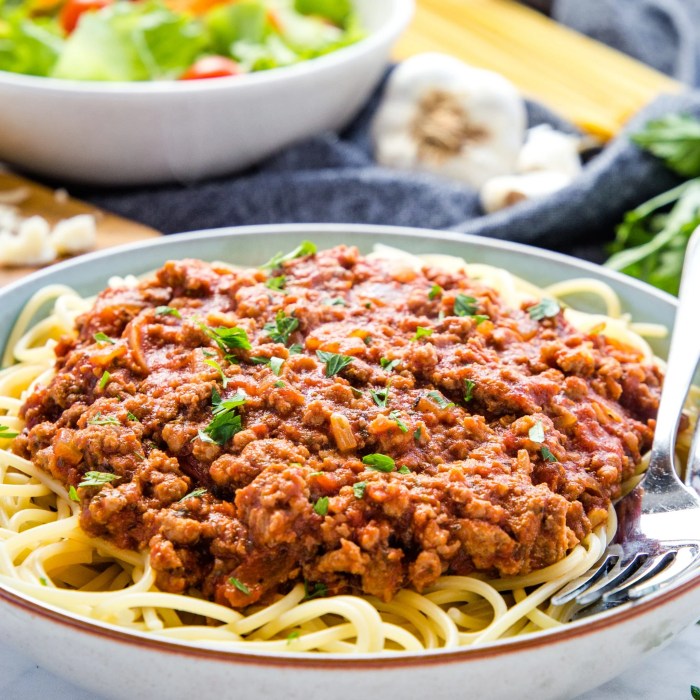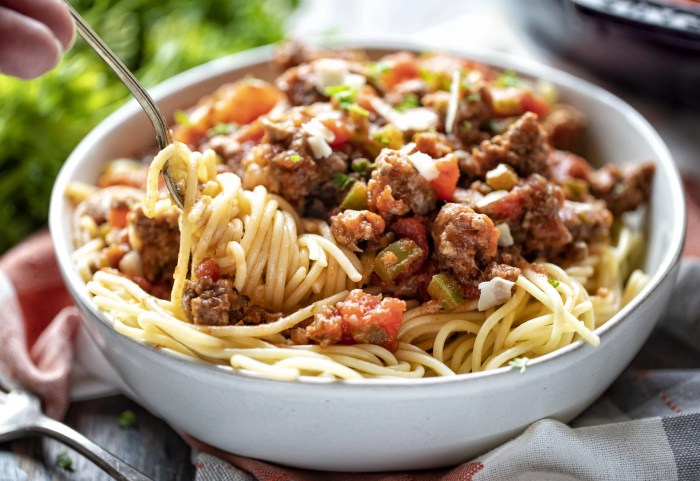Simple Spaghetti Meat Sauce Recipe
Simple Spaghetti Meat Sauce: A Culinary Exploration: Simple Spaghetti Meat Sauce Recipe

Source: thebusybaker.ca
Simple spaghetti meat sauce recipe – This guide delves into the art of crafting a simple yet flavorful spaghetti meat sauce, exploring variations, ingredient selection, cooking techniques, serving suggestions, and troubleshooting tips. We’ll cover everything from choosing the right meat to perfecting the simmer, ensuring a delicious and satisfying meal every time.
Recipe Variations
The beauty of spaghetti meat sauce lies in its adaptability. Here are three variations, each showcasing a different protein, and methods for thickening the sauce.
| Meat Type | Ingredients | Instructions | Notes |
|---|---|---|---|
| Ground Beef | 1 lb ground beef, 1 onion (chopped), 2 cloves garlic (minced), 1 (28 ounce) can crushed tomatoes, 1 tsp dried oregano, salt and pepper to taste | Brown beef, sauté onions and garlic, add tomatoes and oregano, simmer for at least 30 minutes. | For a richer flavor, use a combination of ground chuck and sirloin. |
| Italian Sausage | 1 lb Italian sausage (removed from casings), 1 onion (chopped), 2 cloves garlic (minced), 1 (28 ounce) can crushed tomatoes, 1/2 cup dry red wine, 1 tsp dried basil, salt and pepper to taste | Brown sausage, sauté onions and garlic, add red wine and deglaze the pan, add tomatoes and basil, simmer for at least 45 minutes. | Choose sweet or hot Italian sausage depending on your preference. |
| Ground Turkey | 1 lb ground turkey, 1 onion (chopped), 2 cloves garlic (minced), 1 (28 ounce) can crushed tomatoes, 1/4 cup chopped fresh parsley, salt and pepper to taste | Brown turkey, sauté onions and garlic, add tomatoes and parsley, simmer for at least 30 minutes. | Ground turkey is a leaner option; consider adding a tablespoon of olive oil for richness. |
Three alternative methods for thickening the sauce are:
- Tomato Paste: A tablespoon or two of tomato paste added early in the cooking process will significantly thicken the sauce and add depth of flavor. It results in a richer, more concentrated texture.
- Cornstarch Slurry: Mix 1-2 tablespoons of cornstarch with 2 tablespoons of cold water to create a slurry. Whisk this into the simmering sauce and cook for a few minutes until thickened. This method offers a quick and easy way to achieve a thicker consistency without significantly altering the flavor.
- Reduced Sauce: Simmer the sauce uncovered for a longer period, allowing excess moisture to evaporate. This method concentrates the flavors and naturally thickens the sauce, although it may take more time.
A vegetarian adaptation can substitute meat with a hearty blend of vegetables like mushrooms, zucchini, bell peppers, and eggplant. These provide a substantial texture and earthy flavors to complement the tomato sauce.
Ingredient Selection and Preparation
Using high-quality ingredients is paramount for a superior spaghetti meat sauce. Fresh, flavorful tomatoes, aromatic herbs, and good-quality meat will elevate the dish significantly.
Proper vegetable preparation enhances the overall taste and texture. Onions, garlic, carrots, and celery should be finely chopped for even cooking and to avoid large, uncooked pieces in the final sauce. A sharp knife and consistent chopping technique are key. Dice the onions and carrots into small, uniform pieces (about 1/4 inch). Mince the garlic finely, and chop the celery into small pieces.
Essential pantry staples include:
- Canned Goods: Crushed tomatoes, tomato paste (optional)
- Spices and Herbs: Dried oregano, basil, parsley, salt, pepper, garlic powder (optional)
- Other: Olive oil, onion, garlic, carrots, celery
Cooking Techniques and Timing, Simple spaghetti meat sauce recipe
Proper browning of the meat is crucial for developing rich flavor. The meat should be cooked in batches in a hot pan to avoid steaming. Once browned, remove the meat and set aside. The onions, garlic, carrots, and celery should then be sautéed in the same pan until softened but not browned.
Simmering the sauce is essential for flavor development. A low simmer (around a gentle bubble) for at least 30 minutes allows the flavors to meld and deepen. Longer simmering times (up to an hour or more) result in a richer, more complex sauce.
A step-by-step guide with descriptions (Note: Images are omitted as requested):
- Browning the Meat: Brown the chosen meat in batches over medium-high heat in a large pot or Dutch oven. The meat should be browned evenly, with a slightly crispy exterior. The sauce should have a deep brown color from the browned bits of meat.
- Sautéing Vegetables: Add the chopped onions, garlic, carrots, and celery to the pot and sauté until softened, about 5-7 minutes. The vegetables should be tender and fragrant, with a slightly translucent appearance.
- Adding Tomatoes and Seasoning: Stir in the crushed tomatoes, tomato paste (if using), herbs, salt, and pepper. The sauce should be vibrant red and fragrant with herbs.
- Simmering: Bring the sauce to a gentle simmer, reduce heat to low, cover, and cook for at least 30 minutes, or longer for a richer flavor. The sauce should thicken slightly and the flavors will meld together.
- Taste and Adjust: Taste the sauce and adjust seasonings as needed. The sauce should be well-seasoned, with a balance of sweetness, acidity, and herbs.
Serving Suggestions and Enhancements

Source: iamhomesteader.com
The versatility of spaghetti meat sauce allows for creative serving suggestions.
- Classic Spaghetti: Serve over traditional spaghetti with grated Parmesan cheese.
- Spaghetti Squash: Serve over roasted spaghetti squash for a healthier option.
- Zucchini Noodles: Use zucchini noodles for a low-carb alternative.
- Meatballs: Add homemade or store-bought meatballs to the sauce.
- Baked Pasta: Use the sauce as a base for a baked pasta dish with layers of pasta, cheese, and vegetables.
Fresh herbs like basil, parsley, and oregano enhance the flavor significantly. Add them towards the end of cooking to retain their vibrant color and fresh aroma. A sprinkle of fresh herbs just before serving adds a burst of freshness and visual appeal.
For a visually appealing presentation, consider serving the spaghetti in a shallow bowl, mounding the pasta slightly. Garnish with fresh basil leaves, a drizzle of olive oil, and grated Parmesan cheese.
Troubleshooting and Tips
Common problems and solutions:
- Overly Watery Sauce: Simmer the sauce uncovered for a longer period to reduce excess moisture. Alternatively, use a thickening agent like tomato paste or a cornstarch slurry.
- Burnt Sauce: Ensure the heat is low enough during simmering and stir occasionally to prevent sticking. If the sauce does burn, strain it through a fine-mesh sieve to remove any burnt bits.
Tips for making ahead:
- The sauce can be made a day or two in advance and stored in the refrigerator. The flavors will deepen overnight.
- Reheat gently on the stovetop or in the microwave, adding a splash of water or broth if needed to loosen the sauce.
- Freezing the sauce is also possible. Allow it to cool completely before storing in freezer-safe containers.
Frequently Asked Questions:
| Question | Answer |
|---|---|
| Can I use canned diced tomatoes instead of crushed tomatoes? | Yes, but crushed tomatoes provide a smoother texture. If using diced tomatoes, you may want to pulse them briefly in a blender for a smoother consistency. |
| How long can I store leftover spaghetti meat sauce? | Leftover sauce can be stored in an airtight container in the refrigerator for up to 4 days. |
| Can I add vegetables other than onions, garlic, carrots, and celery? | Absolutely! Mushrooms, bell peppers, zucchini, and eggplant are all great additions. |
Popular Questions
Can I use canned tomatoes instead of fresh?
Absolutely! Canned crushed or diced tomatoes work perfectly well. Just be sure to choose high-quality brands.
How long can I store leftover sauce?
Store leftover sauce in an airtight container in the refrigerator for up to 4 days.
What if my sauce is too watery?
A simple spaghetti meat sauce recipe is a classic for a reason; its comforting familiarity is hard to beat. However, if you’re looking for a change of pace, consider exploring other cuisines, such as the vibrant flavors found in a shrimp in garlic sauce chinese recipe , before returning to your beloved spaghetti. The contrast in tastes can actually enhance your appreciation for the simplicity of the meat sauce afterwards.
Simmer the sauce uncovered for a longer period to reduce the liquid. Alternatively, you can thicken it with a cornstarch slurry (1 tablespoon cornstarch mixed with 2 tablespoons cold water).
Can I freeze the sauce?
Yes, you can freeze the sauce in airtight containers for up to 3 months. Thaw completely before reheating.
What are some good vegetarian substitutes for meat?
Mushrooms, lentils, eggplant, and zucchini are all excellent meat substitutes for a hearty vegetarian sauce.




















